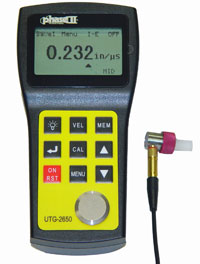 |
| |
| |
 |
| |
| |
 |
|
| Ultrasonic Thickness Gauges |
 State
of the art ultrasonic technology allows you to obtain
ultra precise thickness measurements and store them
to memory. This digital tester is capable of reading
wall thickness down to 0.010" with a super high
adjustable resolution of up to 0.0001". This
dynamic sonic gauge is designed to measure the thickness
of metallic and non-metallic materials such as steel,
aluminum, titanium, plastics, ceramics, glass and
any other good ultrasonic wage conductor as long
as it has parallel top and bottom surfaces. The UTG-2650
will accurately display readings in either inch or
millimeter after a simple calibration to a known
thickness or sound velocity. State
of the art ultrasonic technology allows you to obtain
ultra precise thickness measurements and store them
to memory. This digital tester is capable of reading
wall thickness down to 0.010" with a super high
adjustable resolution of up to 0.0001". This
dynamic sonic gauge is designed to measure the thickness
of metallic and non-metallic materials such as steel,
aluminum, titanium, plastics, ceramics, glass and
any other good ultrasonic wage conductor as long
as it has parallel top and bottom surfaces. The UTG-2650
will accurately display readings in either inch or
millimeter after a simple calibration to a known
thickness or sound velocity. |
| |
Specifications:
| |
Model
No. UTG-2650 |
| Display
type |
4-digit
LCD w/Back Light |
| Display Resolution |
Inch: 0.01", 0.001" or
0.0001" (selectable)
Metric: 0.1mm or 0.001mm (selectable) |
| Measuring
Range |
Standard
Mode: 0.010" - 0.787" (steel) |
| Accuracy |
+/-0.0002" (0.005mm)
if thickness < 3mm
+/-0.002" (0.05mm) if thickness < 20mm |
| Sound
velocity range |
3280-32805
ft/s (1000-9999m/s) Adjustable |
| Upper/Lower
Limit Preset Alarm |
Yes |
| Operating
temperature |
32-122
degrees F |
| Refresh
Frequency |
4MHz
up to 25MHz |
| Memory |
500
Test Values |
| Output |
N/A |
| Power
supply |
AA
alkaline batteries (2pc) |
| Battery
life |
Approx.
200 hours (w/backlight off) |
| Power
consumption |
Working
current is less than 3V |
| Dimensions |
5.86” x
2.87” x 1.25” (149 x 73 x 32mm) |
| Weight |
5.6oz
(160g) |
UTG-2650 comes complete with Certificate of Calibration, Operation
Manual and Custom Carry Case. |
ULTRASONIC WALL THICKNESS GAUGE MEASUREMENT
The use of Ultrasonic non-destructive testing (NDT) to check material properties such as thickness measurement, is now extensively used in all facets of industry. The ability to gauge thickness measurement without requiring access to both sides of the test piece, offers this technology a multitude of possible applications. Metals, plastics, ceramics, glass and other materials can easily be measured by portable ultrasonic thickness gauges with a common accuracy of.001”.
Ultrasonic thickness gauges measure the thickness of a part by measuring the time sound travels from the transducer through the material to the back end of a part, and then measures the time of reflection back to the transducer. The gauge then calculates the thickness based on the velocity of sound through the material being tested.
A broad variety of piezoelectric transducers, operating at given frequencies are utilized to generate sound when excited. Typically, a 5mhz frequency is standard on all Phase II Ultrasonic Thickness Gauges. Optional transducers are always available for a myriad of applications.
The direct contact method of pulse/echo type ultrasonic thickness gauges requires use of a couplant. Propylene Glycol is common, but many other substances can be used.
Easy to configure and use, many gauges today have the ability to retain memory, output to printers, PC’s, and handheld portable devices. With the combination of an easy menu driven gauge and the data in memory, technician/operators have a world of technology at their fingertips to obtain highly accurate and cost effective measurements for all types of thickness applications. |
|
|
| ULTRASONIC THICKNESS GAUGE LINKS |
|
| TRADE SHOWS |
- China Electronics Fair-Shenzhen - Booth 1B157 - Shenzhen
Convention & Exhibition Center - April 9, 2010-April
11, 2010
- IMTS 2010 - Booth E-5217 - Lakeside Center, McCormick
Place, Chicago IL USA - September 13, 2010 - September
18, 2010
|
| |
|
|
 |
|
| |
| |
| |
| |
|
 |